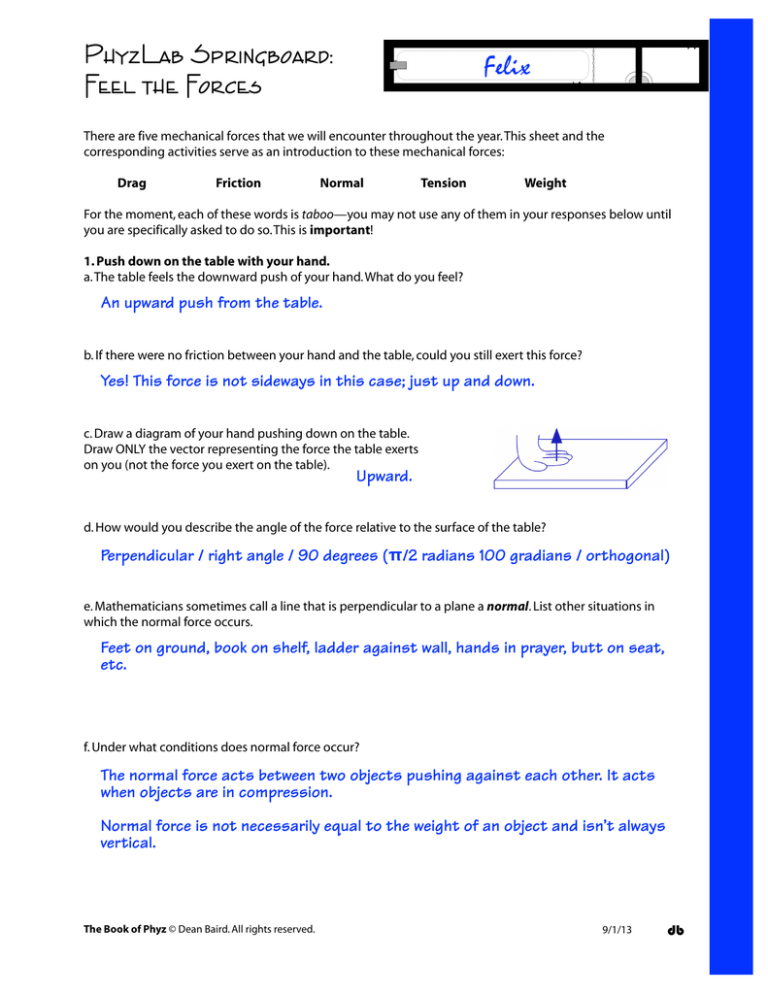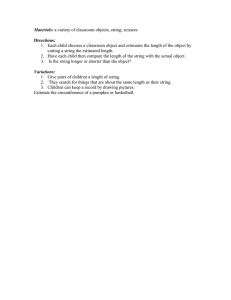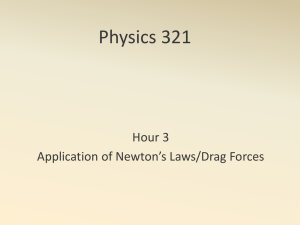
PhyzLab Springboard:
Feel the Forces
Felix
There are five mechanical forces that we will encounter throughout the year. This sheet and the
corresponding activities serve as an introduction to these mechanical forces:
Drag
Friction
Normal
Tension
Weight
For the moment, each of these words is taboo—you may not use any of them in your responses below until
you are specifically asked to do so. This is important!
1. Push down on the table with your hand.
a. The table feels the downward push of your hand. What do you feel?
An upward push from the table.
b. If there were no friction between your hand and the table, could you still exert this force?
Yes! This force is not sideways in this case; just up and down.
c. Draw a diagram of your hand pushing down on the table.
Draw ONLY the vector representing the force the table exerts
on you (not the force you exert on the table).
Upward.
d. How would you describe the angle of the force relative to the surface of the table?
Perpendicular / right angle / 90 degrees (π/2 radians 100 gradians / orthogonal)
e. Mathematicians sometimes call a line that is perpendicular to a plane a normal. List other situations in
which the normal force occurs.
Feet on ground, book on shelf, ladder against wall, hands in prayer, butt on seat,
etc.
f. Under what conditions does normal force occur?
The normal force acts between two objects pushing against each other. It acts
when objects are in compression.
Normal force is not necessarily equal to the weight of an object and isn’t always
vertical.
The Book of Phyz © Dean Baird. All rights reserved.
9/1/13
db
2. Rub your hands together.
a. What factors appear to be important for this force? (What makes it bigger or smaller?)
How hard the hands are pressed together (normal force);
how sticky (or rough) the hands are against each other (surface).
b. List other situations in which this force occurs.
Sliding a box across the floor, slipping while climbing a rope, ...
c. Forces are vector quantities; they have definite directions. In what direction does this force seem to act?
Draw a diagram of a book sliding across the table, moving to the right. Show the total effect of the force
acting on the book by drawing a vector.
>>> book moving right >>>
Against the motion.
d. Give the name (from the list above) and an operational definition for this force.
Friction. A force that acts at the surface between two objects that a sliding
across each other or being compelled to slide across each other
3. a. Suppose Wile E. Coyote were to run off a cliff. What force would lead to his demise?
Weight. (Not "gravity;" gravity’s not even on the list!)
b. What factors appear to be important for this force? (What makes it bigger or smaller?)
Mass (more mass results in more weight)
acceleration due to gravity (on low-gravity moon, objects weigh less; on highgravity Jupiter, objects weigh more).
c. In what direction does this force act? Draw a diagram of Wile E. Coyote; draw the vector for this force.
Not “down.” What about in Australia? Do things fall “up” there?
Toward the center of the earth.
d. Does this force act over long distances through space? (Between the Earth and the Sun, for example?)
Yes; it is sometimes called “gravitational force.”
The Book of Phyz © Dean Baird. All rights reserved.
db
4. Hold one end of the string while your partner holds the other end.
a. Suppose you gently pull while your partner simply holds. Who pulls harder if the string remains at rest?
No one pulls harder: the net force is zero so both pull equally!
b. In what direction does this force act? Draw a diagram of your hand and the string. Then draw a vector
showing the force as it acts on your hand (do not show the force your hand exerts on the string).
The force pulls my hand in
the direction of the string.
c. Does the force act at one end of the string, both ends of the string, or everywhere throughout the string?
i. Consider a chain of rubber bands. If the ends of the chain are pulled, which rubber bands will stretch
the most?
__The ones at the pulled end.
__The ones near either end of the chain.
__All
√ the rubber bands in the chain.
ii. What does this mean about the whereabouts of this force in the string?
The force exists all along the string—at both ends and all points between.
d. i. What is the name of this force?
Tension.
ii. Under what circumstances does this force occur?
Tension occurs in an object that is being pulled apart (stretched). Often (but not
always), the object is a string, rope, chain, or cord.
iii. List other examples of this force.
Telephone lines,
guitar strings,
elevator cables, ...
The Book of Phyz © Dean Baird. All rights reserved.
db
5. Hold the coffee filter above the table and drop it.
a. What two forces are operating as the coffee filter falls?
Weight and Drag.
b. Which force would not be as apparent if the coffee filter were crumpled up?
Drag.
c. In what direction does this force act? Draw a diagram of the falling coffee filter showing the vector for the
total effect of this force. Show the vector for the other force mentioned in part a, too.
Up (opposite the velocity).
d. What is the nature of this force? What’s interacting with what?
Solid interacting with fluid (e.g., air, water) so as to oppose the motion of the
solid through the fluid (or so that the solid opposes the motion of the fluid).
e. Would this force affect
i. a rock falling to the bottom of a pond?
Yes
ii. a feather falling on the moon?
No
f. List other situations in which this force occurs or is particularly important.
Moving cars, oil tankers, baseballs, parachutes ...
g. What factors appear to be important for this force? (What makes it bigger or smaller?)
Cross sectional area: bigger area results in more drag
shape: more aerodynamic shape results in less drag
speed: greater speed results in more drag
fluid density: greater density results in more drag
6. Draw the vectors for the forces acting on the runner.
• Drag hint: where does a solid object move through fluid?
• Friction hint: where might two surfaces slip?
• Normal hint: where are two objects in compression?
• Tension hint: where is an object being stretched (pulled apart)?
• Weight hint: where is an object being attracted to the earth?
T
D
N
W
ƒ
The Book of Phyz © Dean Baird. All rights reserved.
db




